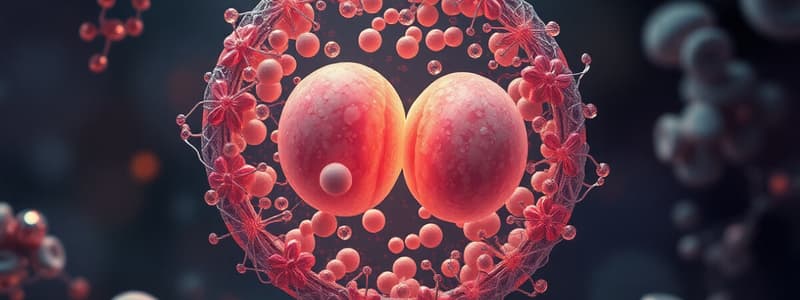Podcast
Questions and Answers
What occurs during the S phase of interphase?
What occurs during the S phase of interphase?
- The cell prepares for division by checking for errors.
- Cytokinesis begins.
- DNA replication takes place. (correct)
- The cell grows in size and synthesizes proteins.
Which phase of the cell cycle involves the growth of the cell and synthesis of proteins needed for DNA replication?
Which phase of the cell cycle involves the growth of the cell and synthesis of proteins needed for DNA replication?
- S phase
- G1 phase (correct)
- M phase
- G2 phase
What is a consequence of errors in the cellular reproduction process?
What is a consequence of errors in the cellular reproduction process?
- Uncontrolled cell growth (correct)
- Increased cell repair efficiency
- Improved DNA replication
- Enhanced organism growth
Which phase prepares the cell for division and checks for errors in DNA replication?
Which phase prepares the cell for division and checks for errors in DNA replication?
Cellular reproduction is essential for which of the following reasons?
Cellular reproduction is essential for which of the following reasons?
What is the primary purpose of mitosis in multicellular organisms?
What is the primary purpose of mitosis in multicellular organisms?
During which stage of mitosis do the chromosomes align at the metaphase plate?
During which stage of mitosis do the chromosomes align at the metaphase plate?
What is a key difference between mitosis and meiosis?
What is a key difference between mitosis and meiosis?
What process during meiosis contributes to genetic variation in the offspring?
What process during meiosis contributes to genetic variation in the offspring?
What characterizes the daughter cells produced after meiosis?
What characterizes the daughter cells produced after meiosis?
Which phase is NOT part of the mitotic process?
Which phase is NOT part of the mitotic process?
What occurs during interphase of the cell cycle?
What occurs during interphase of the cell cycle?
What is the outcome of meiosis II?
What is the outcome of meiosis II?
Flashcards
Interphase
Interphase
The period of growth and DNA replication before a cell divides.
G1 Phase
G1 Phase
Cell growth and protein synthesis for DNA replication.
S Phase
S Phase
DNA replication to ensure identical copies for daughter cells.
G2 Phase
G2 Phase
Signup and view all the flashcards
M Phase
M Phase
Signup and view all the flashcards
Cellular Reproduction
Cellular Reproduction
Signup and view all the flashcards
Cell Growth and Development
Cell Growth and Development
Signup and view all the flashcards
Repair and Regeneration
Repair and Regeneration
Signup and view all the flashcards
Asexual Reproduction
Asexual Reproduction
Signup and view all the flashcards
Sexual Reproduction
Sexual Reproduction
Signup and view all the flashcards
Cancer
Cancer
Signup and view all the flashcards
Cellular Reproduction
Cellular Reproduction
Signup and view all the flashcards
Mitosis
Mitosis
Signup and view all the flashcards
Prophase (Mitosis)
Prophase (Mitosis)
Signup and view all the flashcards
Metaphase (Mitosis)
Metaphase (Mitosis)
Signup and view all the flashcards
Anaphase (Mitosis)
Anaphase (Mitosis)
Signup and view all the flashcards
Telophase (Mitosis)
Telophase (Mitosis)
Signup and view all the flashcards
Meiosis
Meiosis
Signup and view all the flashcards
Meiosis I
Meiosis I
Signup and view all the flashcards
Meiosis II
Meiosis II
Signup and view all the flashcards
Crossing Over
Crossing Over
Signup and view all the flashcards
Cell Cycle
Cell Cycle
Signup and view all the flashcards
Gametes
Gametes
Signup and view all the flashcards
Study Notes
Cellular Reproduction: Overview
- Cellular reproduction is the process by which cells produce more cells. This is crucial for growth, repair, and reproduction in multicellular organisms.
- Two main types of cellular reproduction exist: mitosis and meiosis.
Mitosis
- Mitosis is a type of cell division that produces two genetically identical daughter cells from a single parent cell.
- It's essential for growth and repair in a wide range of organisms.
- The process involves several key stages: prophase, metaphase, anaphase, and telophase.
- Prophase: The chromosomes condense and become visible, the nuclear envelope breaks down, and the spindle fibers begin to form.
- Metaphase: Chromosomes align at the metaphase plate, which is an imaginary plane equidistant from the two poles of the cell.
- Anaphase: Sister chromatids separate and move towards opposite poles of the cell.
- Telophase: Chromosomes decondense, the nuclear envelope reforms around each set of chromosomes, and the spindle fibers disassemble. Cytokinesis usually follows, dividing the cytoplasm and creating two separate daughter cells.
- Mitosis ensures that each daughter cell receives a complete and identical set of chromosomes.
- Mitosis differs from meiosis because it does not involve the formation of gametes.
Meiosis
- Meiosis is a specialized type of cell division that produces four genetically unique daughter cells, each with half the number of chromosomes as the parent cell.
- It's essential for sexual reproduction, producing gametes (sperm and eggs) in animals and spores in plants.
- Meiosis has two rounds of division: meiosis I and meiosis II.
- Meiosis I: Homologous chromosomes pair up, exchange genetic material (crossing over), and separate; resulting in two haploid cells.
- Meiosis II: Sister chromatids separate, similar to mitosis; resulting in four haploid cells.
- Crossing over during meiosis I is a key source of genetic variation.
- The end result of meiosis is four genetically unique daughter cells, each with half the number of chromosomes of the parent cell.
- Meiotic cell division is crucial for genetic diversity within a species, as it generates unique combinations of genes through the process of crossing over.
Phases of the Cell Cycle
-
The cell cycle is a series of events that takes place in a cell as it grows and divides.
-
The cell cycle consists of interphase (G1, S, G2) and M phase (mitosis and cytokinesis).
-
Interphase is the period of growth and DNA replication before a cell divides. G1, S, and G2 phases are included in the interphase.
-
G1 (first gap phase): The cell grows in size and synthesizes proteins needed for DNA replication.
-
S phase (synthesis phase): DNA replication occurs, ensuring that each daughter cell receives an identical copy of the genome.
-
G2 (second gap phase): The cell continues to grow and prepares for the division process, checking for any errors in DNA replication.
-
M phase: The period of cell division, involving both mitosis and cytokinesis.
Significance of Cellular Reproduction
- Cellular reproduction is fundamental to life's processes, making it crucial for:
- Growth and development: In multicellular organisms, cellular reproduction is vital for increasing the number of cells as the organism grows.
- Repair and regeneration: Damaged or diseased cells need to be replaced through cellular reproduction to maintain the health of the organism.
- Asexual reproduction: In some organisms, cellular reproduction is the sole method of reproduction.
- Sexual reproduction: In sexually reproducing organisms, cellular reproduction (meiosis) creates gametes necessary for reproduction.
- The controlled process of cell reproduction is finely regulated. Errors in this process can lead to uncontrolled cell growth (cancer).
Studying That Suits You
Use AI to generate personalized quizzes and flashcards to suit your learning preferences.




